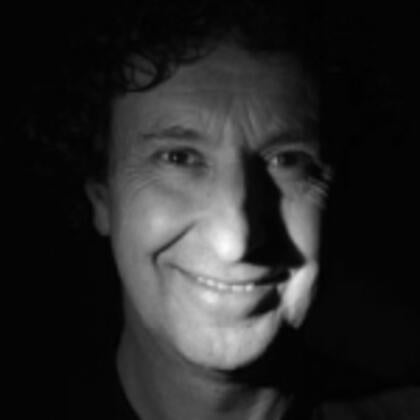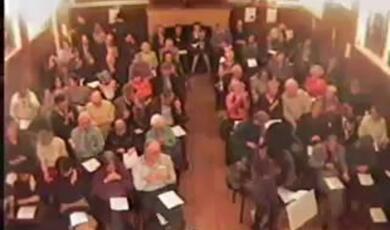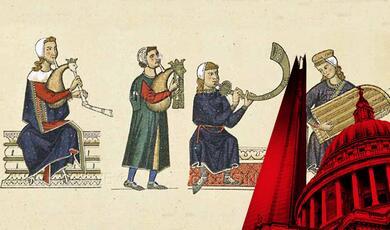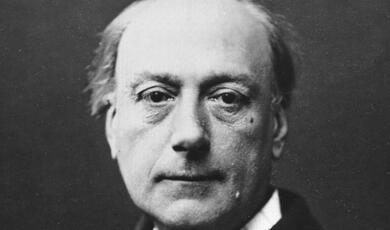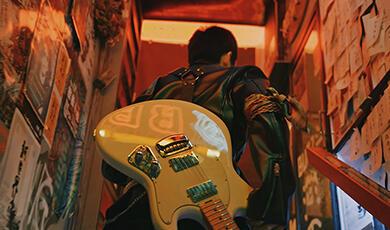Mahler’s London
Share
- Details
- Text
- Audio
- Downloads
- Extra Reading
Architect Keith James Clarke describes Mahler's one and only visit to this great city during the summer of 1892. This lecture outlines Mahler's impressions of London, where he lived and worked and the impact he had on the music-loving public of the day.
Download Text
Gresham Lecture, Wednesday 25 May 2011
Mahler's London
A look at Gustav Mahler's visit during the summer of 1892
Keith James Clarke
London was comparable to what, 'one feels upon seeing the ocean for the first time. The spectacle is so imposing that one suddenly understands what has happened to humanity'.
Mahler wrote this comment following his arrival to this city during the summer of 1892. He was to spend 57 days here during which time he enhanced his reputation as a performing artist and provided a distinctive contribution to the cultural life of London.
Mahler's London. In 1892 London was the World's largest metropolis with a population of 6.5 million, compared to 4 million in New York and 2.7 in Paris.
Prior to his visit Mahler was the Director of the Hamburg Opera House. In Hamburg he had directed a series of operas by Wagner and Beethoven, many of which he would also perform here. Originally Mahler was contracted to conduct nine performances in London but demand for tickets outstripped availability and the schedule was increased by nine extra performances. We should not be surprised by the interest created by the arrival of Mahler. His reputation as a conductor was highly respected. But performances of his compositions had, for the most part, been greeted with hostility and general bemusement. For example, the premiere of his First Symphony was so disappointing that Mahler avoided friends and family after the performance to ease the embarrassment.
As a conductor Mahler's exceptional abilities had been recognised at an early age and Directorships at Leipzig, Budapest, Hamburg and most notably The Vienna Opera House in 1897, (Mahler was 37), had propelled his career beyond his wildest expectations. Despite Mahler's lack of recognition as a composer at this time his work in the Opera House informed his symphonic output. In particular the work of Wagner, Schubert, Beethoven, Mozart, Berlioz and Verdi influenced his compositions. They helped him refine his orchestral texture and unique sound.
Drury Lane at the time of Mahler's visit- the streets were busy with pedestrians and horse drawn carriages.
London Performances
Opera performances included Tannhäuser, Siegfried, Rheingold, Die Walküre, Götterdämmerung, Tristan and Fidelio and made use of German solo singers. Stage sets were transported from Hamburg and the orchestra recruited from English musicians. Members' from the resident Covent Garden Orchestra were not used- more on this later. Previously Sir Augustus Harris, Manager and Director of Covent Garden, had targeted Richter who had developed an impressive reputation in his performances of Wagner at this time. He had prior commitments in Vienna and this led Harris to offer the contract to Mahler. The cost of performances was financed by advanced ticket sales, but, despite the financial success of the venture, Harris failed to attract his celebrated conductor for a return visit. Mahler had increased his fee and agreement was not reached. Today the work of Sir Augustus Harris is recognized by a sculpture; it is fixed to the front wall of the main entrance of The Drury Lane Theatre.
The Drury Lane Theatre.
It was built some 200 years ago and is the fourth building on this site. The architect was Benjamin Wyatt. The canopy on the left hand side was added ten years after the building was completed. Part of the stage lifting equipment, still working today, was used during Mahler's productions.
The celebrated maestro also conducted at The Covent Garden Opera House. Its appearance has not changed substantially since Mahler's time and is the third building on the site. The architect was Barry. Its imposing frontage uses sculptures from the previous building that was destroyed by fire. -KJC
Mahler's Visit: 26th May- 23rd July 1892
Mahler left Cuxhaven in Germany and arrived in Southampton after a pleasant crossing. The train from Southampton arrived at Waterloo Station. It is likely that Mahler would have taken a cab down Stamford Street and crossed Blackfriars Bridge. He began his stay at The De Keyser's Hotel.
The impressive De Keyser's Hotel was located on the north side of the River Thames, adjacent to Blackfriars Bridge.
This hotel was renowned for accommodating, 'foreigners', who were visiting these shores. It had developed a reputation for high quality accommodation. The hotel no longer stands here- it was built in 1864 and demolished to make way for the Unilever Building, (1931), which stands on this site today. This is one of the most attractive sites in London, just over the river, with a curved frontage and with magnificent views towards St Paul's and beyond to the east end of London. (Tower Bridge was under construction at this time and would have been an impressive sight.) Although Mahler worked very hard while he was here, rehearsals, performances, and an expanded programme of operas, he made time to travel around this busy metropolis. As he peered from his carriage between performances and home one can imagine he would have witnessed a bustling city with horse-drawn carriages, horse-drawn buses, 3, 4, 5 deep with the clatter of horses-hooves, the streets smelling of horse manure- all combined with the atmosphere and excitement of one of the great world cities. This scene is a world apart from the small town of Iglau in Bohemia where he grow up.
After a couple of days at The De Keyser's Hotel Mahler moved to be nearer to Covent Garden and Drury Lane and took up residence in two town houses- the first in Torrington Square and the second in Alfred Place, both in Bloomsbury. Whilst the debate about the boundaries of Bloomsbury continues to this day, most observers agree that to the north lies the Euston Road, the east- Grays Inn Road, to the south- New Oxford Street and to the west- Tottenham Court Road. During 1892, this location was highly respected. It was the home of doctors, lawyers and successful businessmen. But it is no accident that this leafy quarter of London boasts such qualities. During its construction a high level of control was applied to the positioning of shops and the formation of gated squares and this produced a special environment for the middle/upper classes. Servants had their quarters on the top floor where rooms were small and with low ceilings. Many of the imposing 4/5 storey buildings were built between 1780 and 1830. Today the buildings continue to impress- they are extremely beautiful with tall trees defining magnificent squares.
We have no diary of Mahler's visit but I suspect he spent many hours walking around London, sitting in the squares, enjoying a moment of reflection whilst listening to the sounds of the city. Mahler's quotation at the beginning of this text goes a long way to describe his response to the City of London.
69 Torrington Square, Bloomsbury, London
Expansion proposals by The University of London have reshaped the Torrington Square that Mahler witnessed during his visit. The environment has been severely modified. (The 'square' never existed from the beginning- the terraces of Georgian buildings were always separated by a long finger of green comprising of trees and shrubs.)
Torrington Square as it was during Mahler's time. Number 69 is on the left hand side.
Salomon Jacobson owned Mahler's lodging house. It was demolished around 1900. But there remains today fragments, echoes from the past- that demonstrate the environment Mahler witnessed. The northeast corner of Torrington Square comprises six Georgian buildings that define the line of the previous terrace, their form, colour and fenestration are identical to number 69. Much of the landscaped courtyard has also been overtaken by developments. But by visiting the neighbouring 'square'; Gorden Square, one gets a much clearer impression of this place. The buildings are grand and impressive and devoid of excessive decoration characterised by late Victorian architecture. Imposing buildings with attractive details around the tops of doors and windows combine with leafy and surprising quiet courtyards. To walk these streets is a delight!
22 Alfred Place, Bloomsbury
A short walk to the south and west lays Alfred Place, the last corner of Bloomsbury where Mahler stayed before leaving London. He stayed in the logging home owned by Mrs. Mary A Gusterson.
Again this street is wide and impressive but regrettably the buildings today bear no resemblance to those witnessed by Mahler. Nevertheless the frontage, the line occupied by the former Georgian buildings, has been maintained and thankfully there are other features of note. Some plaques of street names, for example, Chenies Street, use an old typeface- signage that Mahler would have used.
Alfred Place. The former Georgian houses were grand and impressive and were designed by George Dance the Younger. The close proximity of Torrington Square meant that Mahler developed a good understanding of this part of London.
Nearby Store Street, is blessed by Victorian buildings in original condition and he would have caught a glimpse of these as he made is way to and from Covent Garden and Drury Lane. A stop for horse- drawn carriages existed within a short distance from number 22 and again Mahler would have used this- especially late at night as he returned home after an evening performance. (He wouldn't have arrived at his lodgings until the early hours of the morning and it would have been unwise walking the London streets at that hour.) In 1892 he didn't attract a huge following- demonstrated by the total lack of photographs of him during his visit to London. He would have enjoyed this anonymity, a pleasure that would fade as his reputation grew in Vienna.
Today where number 22 stood is a furniture shop displaying some very modern and expensive items. The basic footprint has changed from separate large terraced housing with external staircases leading to the basement to wide buildings, some with extensive areas of glazing.
I stated earlier that Mahler never returned to London despite a letter that indicates that a return visit was under consideration. Mahler's performances drew very positive responses from critics and other artists' and Mahler too was pleased with the acclaim. George Bernard Shaw reported, 'The gallery applauded wildly at the end of each act' and Paul Dukas noted, 'a conductor of genius'. Mahler said, 'I had to take a curtain call after each act, and the entire hall shouted Mahler until I reappeared'. But beyond the emotion of Mahler's visit, he himself did have serious concerns. The 'scratch' orchestra was not up to standard. Mahler had lost another summer, depriving him of the one creative act that surpassed all others: composition. But other priorities were beginning to emerge that would have their effect on the organisation of his summers from now on. The following summer, 1893, Mahler composed during his summer in the Salzkammergut, Austria. In 1894 he arranged for the construction of his cottage- his first special place dedicated to the art of composition. He left London on the 23rd July 1892 bound for Berchtesgaden, Austria to meet up with friends and family in a villa beside Salzburg. But he left knowing that he had made a unique contribution. He had brought to one of the great capitals of the world a German Session of Opera. He had given the first complete performance of Wagner's Ring Cycle, (an incomplete performance had been given ten years earlier at the Haymarket Theatre). He had prompted a change in name. Following Mahler's visit the then called, The Italian Opera House became; The Royal Opera House, Covent Garden. (No small matter given the House's current international reputation!)
Mahler's Legacy
So whilst many opera lovers may have lamented Mahler's failure to return to these shores for another season, we can at least recognize that he was turning his attention, during the summers, from conducting to composing. He was to create music for an ill-prepared public- music that is now greeted by rapt applause. Today he is still recognised as one of the greatest conductors, though sadly no recordings exist. Today he is also acknowledged as one of the finest symphonists.
We are now one hundred years from Mahler's death: a very special moment in the history of music. Mahler was right when he said, "My time will come". It has.
Bibliography
Clarke K. J. Mahler's Heavenly Retreats: Encounters with the Master's 'Composing Houses' Oblique Angle Publishing. 2007 (Includes DVD and CD). See website: www.mahlersheavenlyretreats.com Mahler's London
All drawings and text: ©Keith James Clarke, Gresham College, 25th May 2011
This event was on Wed, 25 May 2011
Support Gresham
Gresham College has offered an outstanding education to the public free of charge for over 400 years. Today, Gresham College plays an important role in fostering a love of learning and a greater understanding of ourselves and the world around us. Your donation will help to widen our reach and to broaden our audience, allowing more people to benefit from a high-quality education from some of the brightest minds.


 Login
Login



